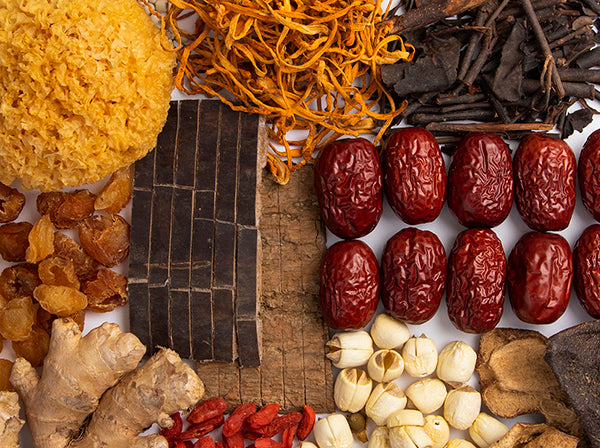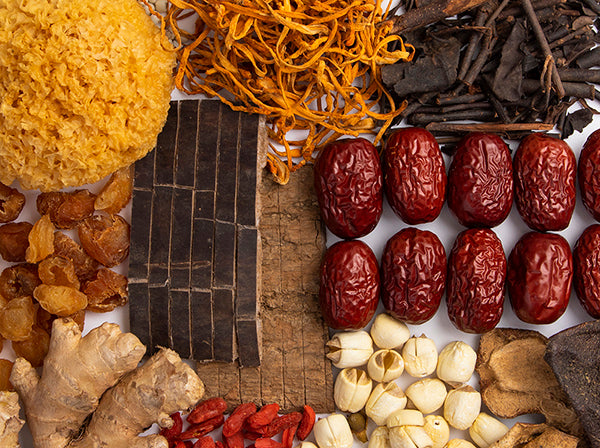Chances are you've heard of Traditional Chinese Medicine (TCM); Perhaps a friend tried acupuncture to induce labor, or you saw an influencer using a rose quartz gua sha on TikTok. Either way, this ancient practice is gaining traction as a holistic enhancement to Western medicine.
Read on to understand the basics of Traditional Chinese Medicine, including its science-backed benefits as well as easy ways to incorporate it into your modern lifestyle.
What is Traditional Chinese Medicine?
The original preventative medicine, Traditional Chinese Medicine is a foundational approach to health, used in China for over 3000 years. Rooted in Taoism and Confucianism, ancient Chinese scholars determined that mind-body balance is key to optimal wellness, disease prevention, and a better quality of life. When illness strikes, Traditional Chinese Medicine restores balance through non-invasive techniques, like herbal medicine and movement or the use of acupuncture.
Though Traditional Chinese Medicine lost popularity in the late 19th century due to western medicine's powerful influence, it slowly started gaining traction again in 1949 as more scientific studies could substantiate its claims.
Today, Traditional Chinese Medicine can be found in over 185 countries and continues to expand its influence as a mainstream alternative medicine practice along with conventional medicine.
What are the health benefits of Traditional Chinese Medicine? Is it safe?
Traditional Chinese Medicine nurtures the body, mind, and spirit as a holistic system. Because it encourages year-round maintenance instead of treating symptoms as they come, Traditional Chinese Medicine leads to ongoing benefits, including reduced stress and inflammation, increased strength and mobility, and better sleep.
Traditional Chinese Medicine can also treat specific health conditions, including diabetes, menopausal symptoms, allergies, and many more. It's always best to let your doctor know if you plan to use Traditional Chinese Medicine and connect with a certified practitioner.
Finally, as Traditional Chinese Medicine is more natural and less invasive than Western medicine, it is generally considered safe, with little to no side effects, when correctly practiced.
What are the main Traditional Chinese Medicine philosophies?
Approaching Traditional Chinese Medicine for the first time can feel intimidating, but it becomes much more digestible once you get the hang of these key principles and terms.
- Yin-Yang: This fundamental concept believes that all-natural phenomena can be broken down into just two forces, yin and yang. These opposite yet complimentary energies coexist to create harmony and health.
Yin is feminine, earth energy—cool and dark, it ebbs and flows with the moon and ocean. Yang is masculine, solar energy, and is warm, bright, and aggressive. When these forces fall out of sync, imbalance occurs, and disease ensues. Not surprisingly, Western culture tends to favor reckless yang energy leading to perpetual disharmony.
When it comes to the body, Traditional Chinese Medicine categorizes each organ into yin-yang to further diagnose imbalances within our system.

- Qi: Another core Traditional Chinese Medicine term, qi (pronounced "chee”), refers to vital energy. This life force flows throughout our body's meridians, pathways connecting our organs and metabolic functions. When qi is flowing freely, we can expect optimal wellness. Conversely, when qi is stagnant or blocked, health problems can arise.
In the body, qi is yang while blood is yin. And by now, you may have guessed that these two elements must exist in harmony for the body to achieve its most resilient state.
- Eight Principles: Traditional Chinese Medicine practitioners use these fundamental principles to assess and correct imbalances that can lead to health conditions. Yin and yang are the most prominent of the eight principles, while the other six synergetic opposites fall within them. They are hot/cold, exterior/interior, and excess/deficiency.
For example:
- The common cold is categorized as exterior because an outside virus has entered the body.
- Chills are classified as cold due to an influx of yin energy while a fever is classified as hot due to an influx of yang
- Intense pain is categorized as excess due to an overabundance of yang
- The Five Elements: The forces of fire, earth, metal, water, and wood define the ebb and flow of yin and yang and how our bodies interact with the world. Though we are constantly in flux, we're each dominated by a single element, which correlates with our personality, body structure, and pre-existing health conditions and can help a Traditional Chinese Medicine practitioner develop a more tailored treatment plan.
Which element do you think you are?
- Fire: Busy, creative, and excited; fire is the center of attention.
- Earth: Nurturing, generous and wise; earth is the balanced element.
- Metal: Responsible, self-reliant and organized; metal is widely respected.
- Water: Spiritual, reflective, and enduring; water is the philosophical element.
- Wood: Confident, driven, and forward-thinking; wood is a trusted leader.
- Body constitution: Traditional Chinese Medicine believes that we each have a unique combination of structural, physiological, and psychological features, such as our age, gender, and mental state. This makeup is known as our body constitution and can determine how susceptible we are to certain diseases.
A Traditional Chinese Medicine practitioner will assess body constitution by examining the skin, hair, tongue, and voice. They may also check nail color, eye brightness, and six pulses on the wrists. From there, they will categorize the unique body constitution across one of nine main types (or a combination of these types) and create a special treatment program.
What are common Traditional Chinese Medicine treatments?
Traditional Chinese Medicine encourages the ongoing practice of the five holistic therapies below. By integrating these practices into our everyday lives, we can take a more foundational approach to health and prevent disease from occurring in the first place.

- Food therapy: In Traditional Chinese Medicine, food is medicine and the first line of defense against disease. A balanced diet made up of fresh, seasonal fare is always in order. And, rather than recommending foods based on vitamins or calories, Chinese food therapy focuses on energetic properties with foods falling along a yin and yang spectrum.
Yin or cooling foods can help reduce too much yang in the body, leading to dryness or constipation. These foods include dark leafy vegetables, mint, watermelon, crab, and tofu.
Yang or warming foods aren't necessarily served hot but instead have properties that heat the body. You may need more yang foods if they are suffering from a cold or virus or are post-partum. These foods include oatmeal, cinnamon, dates, broth, and walnuts.
A Traditional Chinese Medicine practitioner can recommend a personalized diet based on your unique body constitution and ailments.
- Chinese herbal medicine: There are over 11,000 herbs used in TCM for their medicinal qualities. Primarily plant-based, they can be just as powerful as pharmaceuticals: In 2015, Artemisinin (a compound derived from the sweet wormwood plant) was awarded a Nobel Peace Prize for its ability to treat malaria.
Rather than target a specific symptom, Chinese herbal blends treat the underlying cause and are generally recommended for people with acute or chronic conditions like allergies, menstrual disorders, skin conditions, or insomnia. They can also be taken as a preventative measure to boost immunity and regulate the body's systems.
Chinese herbal medicine typically comes in the form of powders, supplements, teas, or pastes that can feature up to 20 different herbal combinations. Pre-blended Chinese herbs are available for more generic issues, while personalized formulas blended by a TCM practitioner are recommended for more specific health concerns.
- Movement: Traditional Chinese Medicine's take on physical exercise is less about losing weight or running a faster mile and more about activating chi to increase energy flow, promote circulation, build strength, and calm the mind. These exercises combine light, repetitive movements with meditation.
Popular Traditional Chinese Medicine movements include tai chi, a series of flowing, low-impact exercises mostly done while standing and paired with deep breathing. Qigong features repeated movements that have a specific goal, like opening the lungs.
These movements can be done inside or outside, alone or in a group, and are often accessible and affordable to start. If you're interested in creating a practice of your own, check out these nine tai chi videos on Youtube.
- Acupuncture: One of the more popular Traditional Chinese Medicine practices in the west, acupuncture involves applying thin needles to the body's pressure points to activate qi. The benefits of acupuncture are numerous: it has been shown to reduce pain, increase mobility, lessen allergy symptoms and even speed up childbirth.
To date, the World Health Organization (WHO) now recommends acupuncture to treat over 28 conditions.
- Manual therapy: This therapy involves using the hands or a hand-held tool to reduce stiffness, restore mobility and ease aches and pains. It includes muscle kneading along with joint manipulation.
You've probably seen photos of a celebrity or professional athlete with large, purplish circles dotting their backsides. While it may look odd at first, these symmetrical bruises are actually the result of cupping. This manual Traditional Chinese Medicine therapy involves a practitioner placing suction cups along the back, stomach, arms, or legs. So what does cupping do exactly? Its vacuum effect expands blood vessels in the treatment area, which may stimulate circulation and stimulate natural healing. Some studies have shown that it can reduce pain, but more studies are needed to verify its effects.
Another popular Traditional Chinese Medicine manual therapy is gua sha, which uses a smooth tool to apply pressure to the skin in long strokes to remove blocked qi. Gua sha may improve circulation, reduce inflammation, break down scar tissue and relieve muscle and joint pain.
Interested in trying Traditional Chinese Medicine?
If you are thinking about adding Traditional Chinese Medicine to your wellness journey, consider starting with NOOCI. These science-backed and sustainably sourced supplements feature time-honored herbal ingredients to help regulate your menstrual flow, reduce allergy symptoms, and more. Plus, they easily fit into a busy lifestyle.
Some more tips to consider before trying Traditional Chinese Medicine include:
- When searching for a specialist, always look for a licensed practitioner with formal training. An excellent place to find a certified Traditional Chinese Medicine specialist in your area is through the National Certification for Acupuncture and Oriental Medicine or The American Association of Acupuncture and Oriental Medicine.
- Give your primary care doctor a heads up so they have a complete understanding of any treatments you might be receiving and how they may interact with your current care. They may also be able to refer you to a practitioner they know and trust.
- If you are pregnant or nursing, connect with your primary care doctor before starting any treatments.


